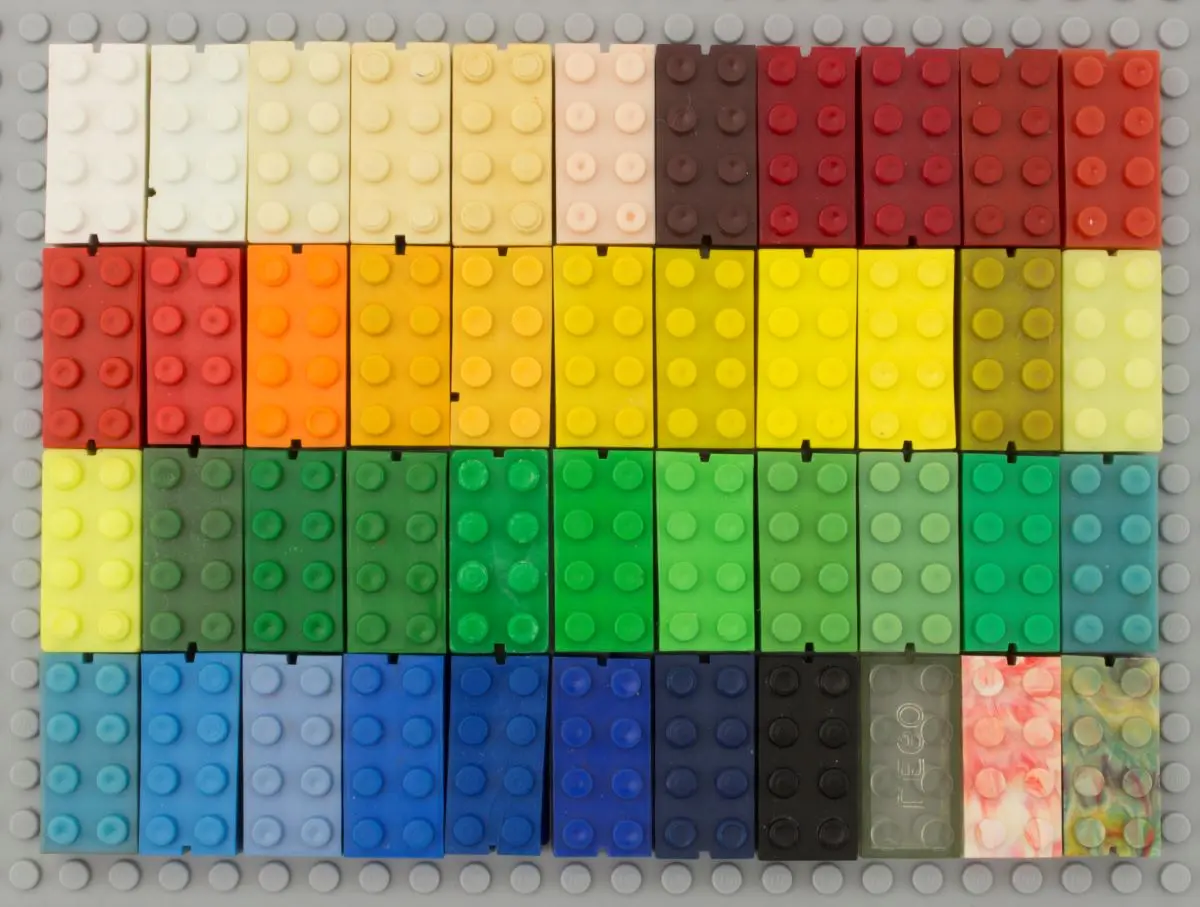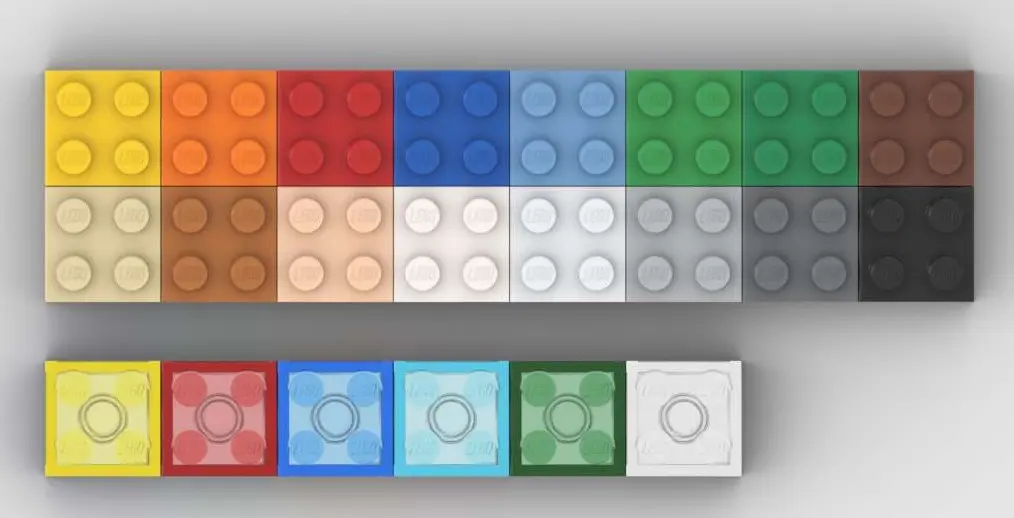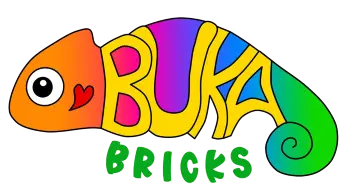The original Turkish version of this article was inspired by Doruk, one of the guest bloggers, who sent me a message one day saying “I think I found an interesting subject for you”. Along with the message was an image, showing the colors black, dark gray, dark bluish gray, light gray, light bluish gray, very light gray and very light bluish gray. He wondered why there were so many color changes, and I realized I didn’t know the answer. So I decided to look into it, and that’s how the history of LEGO colors came into being.
The subject of LEGO colors is really extensive and there are so many detailed articles on it. I’ll start with what I know, and move on to what I found out.
Fifty Shades of LEGO
Although I’ve never heard about very light gray at the time, I knew there was a difference between light gray-light bluish gray and dark gray-dark bluish gray. Since I still have most of my sets from my childhood (the 80s), I have both the old and the new shades of gray. But what was the story behind it?
The change happened around 2004. Most of the pages I visited say it was because of the economic problems the LEGO Group was having. However, Jake McKee, in charge of communicating with LEGO fan groups at the time, explains it like this:
“Around the beginning of 2000, we found ourselves with a color palette that was growing far too quickly, and far too organically. There wasn’t enough vision put into how we were expanding and adding new colors. The decision was made to apply the same type of thinking we now use in approaching the long term element design process to the color palette. The desired outcome was to create a color palette that would work effectively for years to come, and that could scale easily and correctly. We didn’t want to end up with the same out-of-control color situation as we did with elements in the late 90s – that was a hard lesson to learn, but we learned it well.
This initiative led to a revised color palette. This new color palette included some deletions of low-use colors, additions of new colors, and some tweaks to the existing colors. The goal in all these changes was completely and totally focused on creating the absolute best set of LEGO colors possible.
There has been a great deal of assumptions posted about the reasons we made the changes. Everything from trying to copy MEGABloks, to trying to save money on recycling parts. I know it seems hard to believe (unless you really think about the long-term history and attitude of this company), but it really is as simple as trying to create a sustainable and consistent color palette for the future.” *
What was the result? The grays, which were warmer until 2004 became cooler. I remember them being greenish, but apparently they were more yellowish. After the color change, AFOLs started calling it “bluish gray”. They weren’t too happy with the change, and hoped for the LEGO Group to go back. That never happened.
So why did this change had such a big impact? Well, light gray was released in 1954, dark gray in 1961. Every MOC builder used the same colors for 50 years. It may not seem like a lot when the builds are separate, but when a dark gray and dark bluish gray are put next to each other, there’s a tone difference. Some fans protested, saying “I’ll never use them”, some gave up their LEGO hobby altogether (I feel this is a bit too much, but the world of full of strange people). An article on Brickpile says “I think the only reason to prefer the old colors – as most AFOLs did – is because you already have a lot of them. If the new colors had been the ones LEGO made since the beginning, I’m sure nobody would have cared.” Honestly, I agree with that statement.
The History of LEGO Colors
I thought the initial LEGO color palette was very limited. They started with red, blue, yellow, white and black, and added more colors when needed. That wasn’t the case at all. This is what I found out during my research.
Between 1949-1952, LEGO bricks were known as Automatic Binding Bricks. The colors included 3 shades of yellow and orange, 4 shades of green, 3 reds, 4 blues, 2 whites, purple, pink, brown and transparent. There were also marbled bricks, which were considered second rate and cheaper. Today, it’s the opposite.

In 1952, Godtfred Kirk Christiansen (Ole Kirk Christiansen’s son, who’s the founder of the company) thought they needed a more defining name and started to print “LEGO Mursten” on the sets, meaning LEGO Bricks. The color palette was scaled down and only white, red, yellow, blue, green and transparent colors remained. Green was the hardest to find among these.
The LEGO bricks went under a big change between 1958-1978. The biggest change was the tube system being implemented, which is still used today. But the colors disappeared, too. For a long time, only red and white were used in sets. Although there were parts made in blue, yellow, black and trans-clear, they weren’t very common. Green was only used in baseplates and trees.
Near the end of this time period, other colors started to show up in sets again, like blue, yellow and black. Light gray was added with the Classic Space theme, green and pink was added to the color palette.
Between 1978-1997, the LEGO color palette went crazy. Near the end, there were almost more than 100 different colors. The economic problems had the LEGO Group go over them, and around half of them were discontinued.
The years between 1997-2003 were the recovery years of the company. No colors were added to the palette, but there were still a lot of them.

And 2004! It’s the nightmare year for AFOLs. The grays changed, brown turned to reddish brown, pink to bright pink. There were other small changes as well. A new brown was added, a little darker than the first, called dark brown. For some reason, the changes made to brown weren’t as dwelt upon as the grays.
In November 2004, Jake McKee published a list, called Universal Colors (or Locked Colors). It meant “An evergreen color that would not be changed, dropped, or modified without serious discussion that includes all stakeholders, including adult hobbyists and LEGO Company executive management.” There were 16 solid and 6 transparent colors on it. The colors were yellow, orange, red, blue, medium blue, bright green, green, reddish brown, tan, nougat, light nougat, white, very light bluish gray, light bluish gray, dark bluish gray, black, trans-yellow, trans-red, trans-blue, trans-light blue, trans-green and trans-clear.

Names of LEGO Colors
There are (at least) two different color names. The first is the official LEGO name, the others are given by fans. Sometimes they are similar, but usually not the same. There are tables comparing these names so we can learn what the LEGO Group calls a color we call green.
There are 181 colors under 10 categories in Bricklink, while Brickset has 189 colors under 10 categories. These names probably don’t have official names in Turkish, but I did find a partial table that translates some of them.
There have been more than 250 different LEGO colors so far. Most of these can’t be found in sets today, and some can’t be found in sets at all. I wasn’t able to find a Universal Color List announced after 2004, at least not officially, but color palettes have appeared in videos from time to time. The image below shows the 2020 Color Palette seen in a LEGO DOTS video.
When you say LEGO colors, there’s one person who shines out: Rylie Howerter. He has done such comprehensive work on them, published different articles on different LEGO blogs. After getting interested in the subject, he started to collect all the different LEGO colors he could find, and photographed them. He also has an amazing color chart. With his permission, I translated it into Turkish, and simplified it a little. You can see my version here and Rylie’s original table here.
Sources
Like I said, it’s an extensive subject. There have been lots of different articles until now. As I was writing this article, I read many of them. You can find some of these below.
- The Brick Blogger – LEGO colors – introduction (the history section is taken mostly from here)
- Hobby DB – A Brief History of LEGO colors
- New Elementary – Old Bricks: 5 Classic LEGO Colours
- Brick Architect – Understanding the LEGO Color Palette
Finally, I’d like to thank Rylie Howerter for allowing me to publish his table in Turkish and Elspeth Demontes for answering my questions. And of course, I thank Doruk for sending me down the rabbit hole :)
* Taken from Jake McKee’s statement.
All images belong to Rylie Howerter, except the ones showing shades of gray and Universal Colors (2004).
Some girls play with Barbie dolls, while others create small worlds with LEGO minifigures and continue to do so when they grow up. You can probably guess which group I belong to :)



